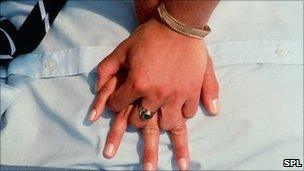Study backs chest compressions in resuscitation
- Published

Official guidelines show that 30 chest compressions should be followed by two rescue breaths
Concentrating on chest compressions rather than mouth-to-mouth when giving emergency resuscitation can produce better results, says research published in The Lancet.
A study of 3,000 patients found that chest compressions alone increased chances of survival by more than 22%.
But training in how to give both chest compressions and mouth-to-mouth breaths is the best option, experts say.
The UK Resuscitation Council is due to produce new CPR guidelines next week.
Cardiopulmonary resuscitation (CPR) is a combination of chest compressions and mouth-to-mouth breaths, given in the event of a cardiac arrest.
The study, compiled by doctors from the Medical University of Vienna in Austria, looked at the survival rates of people treated by untrained members of the public taking instructions from the emergency services over the phone.
Dr Peter Nagele, from the department of anaesthesiology, critical care and pain therapy at the Medical University of Vienna, said that if untrained bystanders avoided mouth-to-mouth breaths during CPR, they were more likely to perform uninterrupted chest compressions.
That then increased the probability of CPR being successful.
Different techniques
The research in The Lancet involved two analyses.
The first used data from three randomised trials involving more than 3,000 patients.
It showed that chest-compression-only CPR was associated with a slightly improved chance of survival compared with standard CPR (14% v 12%).
In the second analysis of seven observational studies, researchers found no difference between the two CPR techniques.
The study authors maintain that continuous, uninterrupted chest compressions are vital for successful CPR.
Dr Jas Soar, chair of the Resuscitation Council from Southmead Hospital in Bristol, said: "Any CPR is better than no CPR. If you witness a cardiac arrest, dial 999 immediately. Those trained in CPR should follow existing guidance of 30 chest compressions followed by two rescue breaths.
"Those not trained should start compressions and follow instructions until an expert arrives," Dr Soar said.
Dr Meng Aw-Yong, medical adviser at St John Ambulance, acknowledged that rescue breaths could be off-putting.
"The current advice is that if you're unwilling or unable to do full CPR then chest compressions are better than nothing.
"The best solution, however, is for people to get trained in how to carry out chest compressions and rescue breaths so they can be the difference between a life lost and a life saved," he said.
The British Heart Foundation says that being able to do CPR more than doubles the chances of survival.
Claire O'Neill, community resuscitation programme lead at the BHF, said: "For someone who is untrained in cardiopulmonary resuscitation, doing both chest compressions and rescue breaths really can be difficult.
"We also know that uninterrupted chest compressions are very important for increasing the chance of survival. So being directed to focus solely on chest compressions could make people more willing to attempt resuscitation, which could ultimately save lives," she said.